 Simple Steps to Look Great
in a
Veil, or Veil-and-Circlet, with photos.
Simple Steps to Look Great
in a
Veil, or Veil-and-Circlet, with photos.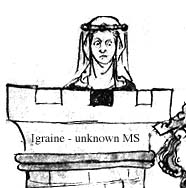
 Simple Steps to Look Great
in a
Veil, or Veil-and-Circlet, with photos.
Simple Steps to Look Great
in a
Veil, or Veil-and-Circlet, with photos.
by Cynthia du Pré Argent
© 2000-2004 Cynthia Virtue
It is not difficult at all to look really nice in a veil, (see details below for men) and be freed from the worry of it coming off, inching up, or blowing around too much in the wind. Try using the bands of fabric method. (Some other methods are also described herein.)
The things you need are:
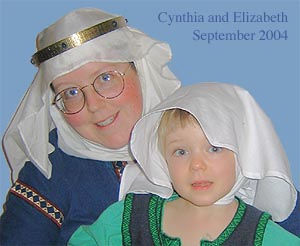 The ideal shape of the top of the veil
should be as if it were just
lying on your head like a tablecloth -- with apparently natural folds
and ripples from around the temples downward. There shouldn't be
a lot
of angularity above the veil, nor should it be perfectly smooth and
tensioned across the top and back, showing your skull's shape.
The ideal shape of the top of the veil
should be as if it were just
lying on your head like a tablecloth -- with apparently natural folds
and ripples from around the temples downward. There shouldn't be
a lot
of angularity above the veil, nor should it be perfectly smooth and
tensioned across the top and back, showing your skull's shape.
If you like, you can also wear
a circlet, but the circlet is not
how the veil is kept on your head, so
you don't need to cram it down. If you attach this well,
you can do anything and everything in your veil and bands, from walking
in a strong wind to doing kitchen work, to hanging upside down, and
your veil will not come off.
Keep in mind that some SCA
kingdoms have sumptuary customs that say metal circlets are reserved,
and most kingdoms reserve the fancier "coronets" for folks of certain
stations. If you like the circlet look, yet are not eligible for
one, you can make one out of stiffened ribbon or trim. Use of a
stuffed roll about 1" across, as seen at many renaissance faires, is
not supported by any medieval or renaissance image.
The coronet pictured below is my Court Baroness coronet, but any
coronet follows the same aestheics for wearing, whether for men or
women. Men, of course, would not wear a veil and bands, but
should wear the circlet as pictured, level, at the hairline, and not
dropping back along the back of your head.
Note that although you can see the chin band in some medieval
paintings and statues, the horizontal band is by its nature, invisible,
and thus its use is somewhat open to argument. I am hoping to
find more medieval illustrations or solid documentation (such as a
household
account, diary, sumptuary mention) of the horizontal band; if you have
seen one, please drop me a note. I am indebted to Eilis of
Eisental, who found the top left image in the Murthly Hours, which
clearly shows forehead and chin bands on two women.
I am quite convinced of its accuracy, but that doesn't mean you have to be. The folks that first showed me this method probably got it from Calthrops English Costume.
It should be noted that this page is entirely for headwear prior to about 1300; after that, some "rules" changed, most notably, even complex headdresses seem to be mostly without chin bands of any sort, although it is a mystery how they stayed on.
Let's get started. First, some terminology for the purposes of this page.
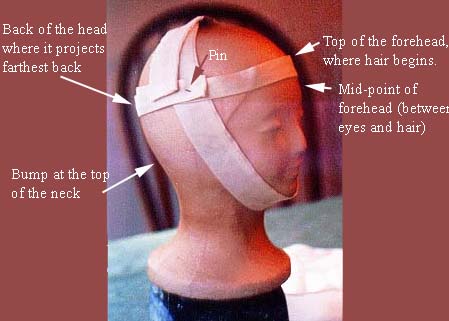
Note that the styrofoam head is very small relative to most real
people. The chin band here is about an inch wide; yours should
not
cover your whole chin-to-neck distance.
|
|
|
|
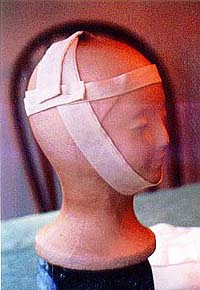 |
The first step: Fastening the bands.
Both bands should be snug, but not uncomfortably tight. The first band is the chin-strap, sometimes called "the
barbette" (little beard). This wraps under the chin and reaches
back, covering the ears, and is pinned at the top of the head, slightly
back from the place you'd balance a book on your head. (The bands overlap more on the dummy's head than they do on my own head. It's a tiny styrofoam head!) |
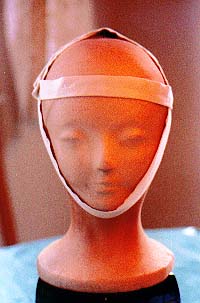 |
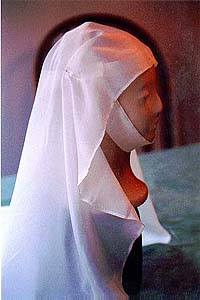 |
Second step: putting on the veil.
Center the veil on your head, with the front edge just over
the lower edge of the forehead band. Pin in the center of the
forehead band. Sometimes I pin in the center back on the horizontal band. Once it is pinned on, you (or a friend) can go back and pin it
again,
making a small pleat of fabric. This pleat will help the edge of
the veil that frames your face fall in a pretty ripple fashion. You can stop at this step if you don't want to wear a circlet. |
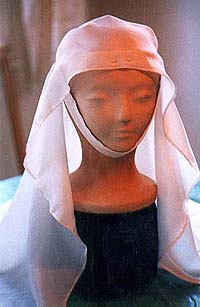 |
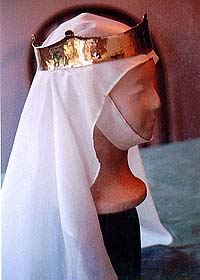 |
If you want to wear a circlet, it goes on last.
Circlets and coronets look best if they are only doing their
job of being ornamental; since your veil is already held securely by
the
bands, they just sit on your head and look good. |
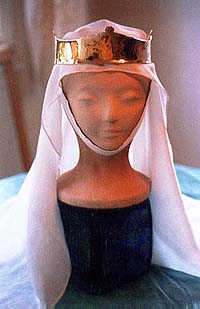 |
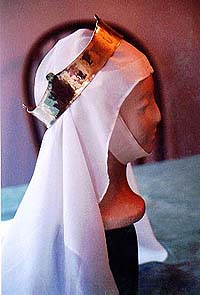 |
These are photos of how not to wear a circlet.
Notice that the circlet in front is about two inches behind or
above the hairline, and in back, it is so low that you can see the
curve
of the back of her head. |
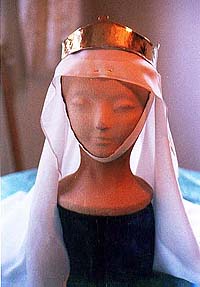 |
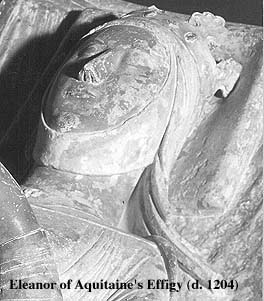 Other methods
of keeping your veil on which work and might be period:
Other methods
of keeping your veil on which work and might be period:
I plan to post a few pictures of medieval women wearing crowns here, for corroboration, but until I do that, please refer to the other early-period garb pages that I have, for pictures.
If anyone reading these pages has a medieval example of women wearing their crowns in the way that I tell you not to do it, please drop me a note. I'm fairly certain that you won't find any, but would like to know if I'm wrong. I belive these methods and opinions are accurate for most Northern European cultures that wore veils and crowns.
One contrary artist's examples have been brought to my attention --
check out the crowns at the French
Library; I'm not sure if this is only an artistic convention, or
reliable documentation of a true counter-example, but some of them have
the fronts at the bangs and the backs of the crowns very far back on
their heads. I still think that someone will look awkward to do
otherwise than keep the crown on a strictly horizontal orientation.
| All material © 2000 Cynthia Virtue | Email Author with comments |
| Back to Virtue Ventures Main Page | Back to Article Index |